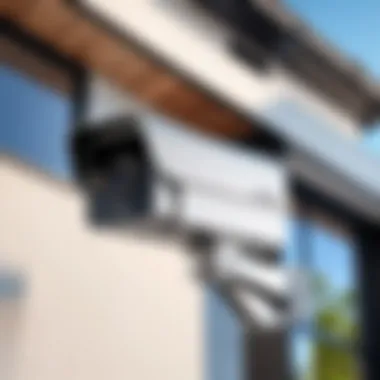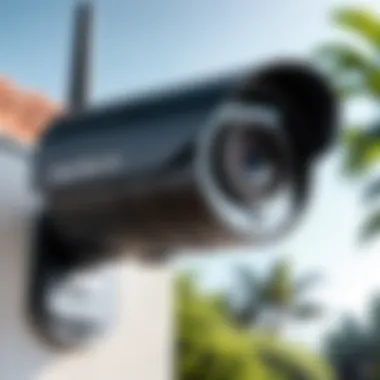Comprehensive Guide to Outdoor Security Cameras


Intro
Outdoor security cameras have become an essential component for both residential and commercial security systems. They offer an effective solution for monitoring property and deterring potential threats. With advancements in technology, these cameras have evolved significantly, making it crucial for IT professionals and tech enthusiasts to stay informed about current trends, types, features, and installation best practices.
This guide aims to provide an exhaustive exploration of outdoor security cameras. We will delve into the key aspects that need consideration when selecting and implementing these crucial devices. Topics will include various camera types, technical specifications, performance evaluations, and emerging technologies that influence outdoor surveillance solutions.
By understanding the nuances of outdoor security cameras, readers will be better equipped to enhance security measures tailored to their specific needs. From the latest market trends to case studies demonstrating real-world application, this guide reflects a comprehensive understanding of outdoor surveillance solutions.
Advantages of outdoor security cameras include:
- Deter criminal activity through visible surveillance.
- Monitor live feeds or recorded footage for improved awareness.
- Integration with smart home technology for enhanced user control.
Overall, the information provided in this guide will enhance the decision-making process required for effective outdoor security implementation.
Foreword to Outdoor Security Cameras
Outdoor security cameras have grown essential in both residential and commercial properties. Their significance lies in the ability to monitor activities and deter potential threats. Effective surveillance provides a sense of safety and peace of mind, which is critical in today’s environment. High-quality video feed from these cameras helps in documenting events as they unfold, thus aiding law enforcement when needed. In essence, outdoor surveillance acts as a guardian against theft, vandalism, and other misdemeanors.
Importance of Outdoor Surveillance
The need for outdoor surveillance arises from the heightened concern over personal and property security. Recent studies indicate that homes equipped with visible security cameras are far less likely to be targeted by intruders. This statistic underscores the preventive capabilities of visible surveillance technology. Furthermore, outdoor cameras facilitate real-time monitoring and remote access, which empowers homeowners and business owners to manage their security effectively.
Outdoor surveillance can also assist in resolving disputes, providing valuable evidence that might be required for insurance claims or legal situations. This capability is not just about deterrence; it is about establishing a comprehensive security system that adapts to various needs. In a nutshell, outdoor surveillance offers a multipronged approach to maintaining safety.
Evolution of Security Camera Technology
The evolution of security camera technology has been remarkable, transitioning from basic analog systems to sophisticated digital options. Early models provided limited quality and connectivity. However, advances in technology have led to cameras offering high-definition video, enhanced night vision, and cloud storage capabilities.
In recent years, the integration of Internet of Things (IoT) technology has transformed how outdoor cameras operate. Now, they can sync with smart home systems, providing enhanced interactivity and remote control options. Artificial intelligence has further revolutionized this field, introducing features such as person recognition and automatic alerts.
As security threats become more sophisticated, security cameras must evolve continuously. The current landscape reflects a commitment to improving both functionality and ease of use. Keeping abreast of these changes helps IT professionals and tech enthusiasts make informed purchasing decisions.
Types of Outdoor Security Cameras
Understanding the different types of outdoor security cameras is crucial for ensuring effective surveillance. Each type has unique features, advantages, and limitations which fit various needs. Recognizing these differences helps in making informed choices, ultimately enhancing security measures. Here are some prominent categories:
Wired Security Cameras
Wired security cameras connect directly to a recording device. They offer a reliable connection and often superior video quality since they are less prone to interference. Setting them up requires running cables through walls or ceilings, which might be challenging in some installations. However, once in place, they generally provide consistent performance over time. Ideal for those seeking professional-grade surveillance, wired cameras can handle harsh weather conditions without compromising functionality.
Wireless Security Cameras
Wireless security cameras have become popular due to their simple installation process and flexibility. They transmit video signals through Wi-Fi, requiring only power sources to operate. While they are easier to install than wired models, they can face issues such as network interference or bandwidth limitations. Users must ensure their Wi-Fi signal is strong enough for reliable connection. Battery-operated options are available, but they require regular maintenance to change or recharge batteries. These cameras are a great choice for residential setups, especially where cabling is difficult or unwanted.
PTZ Cameras
PTZ, or Pan-Tilt-Zoom, cameras provide a higher degree of control over surveillance areas. Users can remotely adjust the camera's view, allowing for comprehensive monitoring of large spaces. PTZ cameras are equipped with motors that enable the lens to pan horizontally, tilt vertically, and zoom in on subjects. They are often utilized in commercial settings, such as parking lots or stadiums, to cover extensive areas with fewer cameras. While they offer significant versatility, they can be more costly than fixed-position cameras and may require advanced user training to operate.
Bullet vs. Dome Cameras
When considering bullet or dome cameras, the decision often hinges on situational requirements. Bullet cameras are distinct with their elongated shapes that allow for focused surveillance. They are easily noticeable, acting as a deterrent for potential intruders. However, their exposure can make them vulnerable to vandalism. On the contrary, dome cameras are compact and subtle, making them less conspicuous. They have a wider field of view and are typically more resistant to tampering. Factors like environment, aesthetics, and specific monitoring needs will dictate which camera type is more suitable for an installation.
Key Features to Consider
When selecting outdoor security cameras, various features must be taken into account. These elements not only enhance the camera’s functionality but also improve the overall effectiveness of your surveillance system. Understanding these key features can guide IT professionals and tech enthusiasts in making well-informed choices. Each feature contributes significantly to ensuring the safety and security of property, aligning technological prowess with practical applications.


Resolution and Image Quality
The resolution of a security camera is one of the most critical aspects. Higher resolution translates to clearer images, which are essential for identifying faces, license plates, and other vital details. Cameras typically range from 720p to 4MP or more. Choosing a camera with at least 1080p resolution is recommended for most outdoor settings.
- Benefits of Higher Resolution:
- Considerations:
- Improved image clarity in bright or low-light conditions.
- Greater detail captured, aiding in evidence collection.
- Higher resolution cameras require more storage space.
- Bandwidth can be impacted, especially with multiple cameras running simultaneously.
Night Vision Capabilities
Effective surveillance extends beyond daylight hours. Night vision capability significantly enhances the camera's utility. Many cameras utilize infrared (IR) technology to capture clear images in complete darkness.
- Types of Night Vision:
- Benefits:
- Infrared Night Vision: Ideal for total darkness, using IR LEDs to illuminate the area.
- Color Night Vision: Some cameras offer enhanced night vision using low-light technology for color images.
- Continuous monitoring regardless of lighting conditions.
- Provides greater security against nocturnal intrusions.
Motion Detection and Alerts
Motion detection functionality is an indispensable feature for outdoor security cameras. This technology activates recording when movement is detected, reducing storage use and focusing on relevant events.
- Alert Systems:
- Benefits of Motion Detection:
- Instant alerts can be sent to users via Smartphone apps or emails when motion is detected.
- Some systems allow for customized detection zones, minimizing false alerts from pets or passing vehicles.
- Reduces unnecessary footage, making it easier to review recordings.
- Enhances the responsiveness of security measures to potential threats.
Weather Resistance Ratings
Given that outdoor security cameras must endure various environmental conditions, understanding their weather resistance is crucial. Cameras are often rated according to the Ingress Protection (IP) code system, which indicates their durability against dust and water.
- Common Ratings:
- Considerations When Choosing:
- IP65: Dust-tight and protected against water projected from a nozzle.
- IP67: Completely dust-tight and can withstand temporary immersion in water.
- Location and climate should dictate the necessary weather resistance rating.
- Ensure cameras can operate effectively in temperature extremes from hot summers to frigid winters.
Installation Considerations
Installation considerations play a significant role in ensuring that outdoor security cameras operate effectively and meet specific surveillance objectives. Proper installation not only enhances camera functionality but also influences the overall security of the property. Various elements contribute to a successful installation, including the camera location, wiring, setup of wireless systems, and integration with existing security infrastructure. These factors can affect both the capabilities and the reliability of the surveillance system.
Choosing the Right Location
Location is critical when it comes to outdoor security cameras. The right placement can mean the difference between effective monitoring and blind spots. Here are some key points to consider:
- Coverage Area: Identify the areas that require monitoring. Common spots include entrances, driveways, and backyards.
- Height and Angle: Elevating the camera reduces the risk of tampering. Additionally, the angle of the camera should maximize visibility of the area.
- Lighting Conditions: If a camera is placed in a poorly lit area, it may not capture usable footage, especially at night. Consider additional lighting if necessary.
- Visibility of the Camera: A visible camera can act as a deterrent for potential intruders. Conversely, a hidden camera may be more effective in gathering intel without alerting suspects.
Each of these considerations contributes to a well-planned installation that maximizes the utility of surveillance equipment.
Wiring Requirements for Wired Cameras
Wired cameras offer stable connections and generally deliver superior image quality compared to their wireless counterparts. When planning the installation of wired security cameras, several wiring considerations are vital:
- Cable Type: Select appropriate cables; coaxial or Ethernet (Cat 5 or Cat 6). The choice affects transmission quality and distance.
- Power Supply: Ensure that the chosen location has access to power sources. Power over Ethernet (PoE) can simplify installation as the same cable supplies data and power.
- Cable Length: Each cable type has distance limitations. For instance, Ethernet cables can generally reach up to 100 meters. Ensure the distance does not exceed these limits to maintain performance.
- Protection Against Elements: Use weatherproof cables and enclosures to prevent damage from outdoor conditions.


These wiring requirements will impact the reliability and functionality of the system, ensuring that the cameras can capture clear and consistent footage.
Setting Up Wireless Systems
Wireless security cameras provide flexibility in installation and often simplify setup compared to wired models. However, several specific considerations must be addressed:
- Wi-Fi Strength: Ensure that the intended camera locations receive strong Wi-Fi signals. A weak signal can lead to data loss or inconsistent video quality.
- Interference Factors: Evaluate potential sources of interference. For example, thick walls, metal objects, or other wireless devices can disrupt the signal.
- Installation of Antennas: Some cameras come with external antennas to boost signals. Proper placement can enhance connectivity.
- Battery Management: If the camera system is battery operated, consider the frequency of battery replacements and whether that affects placement.
By addressing these factors, you can maximize the performance and reliability of your wireless systems.
Integrating with Existing Security Systems
Finally, integration plays a crucial role when adding outdoor security cameras to pre-existing systems. Key factors for a successful integration include:
- Compatibility: Ensure the new cameras can work with the existing security system. Check specifications for compatibility of software and hardware.
- Central Control Hub: Utilize a centralized system for management, as it allows for easier monitoring and control of multiple cameras.
- Software Updates: Regular updates of both the new and existing systems will ensure all components remain functioning well together.
- User Access Management: Define user access levels to safeguard sensitive information captured by surveillance cameras.
Integrating new equipment with existing systems offers a holistic approach to security and can enhance the overall effectiveness of surveillance efforts.
Storage Solutions for Security Footage
Understanding storage solutions for security footage is crucial for effectively managing data generated by outdoor security cameras. As camera technology advances, the volume of footage increases, necessitating robust storage options. This section will delve into local storage options, cloud storage systems, and considerations regarding storage capacity. Each solution presents its unique benefits, challenges, and best practices for the savvy user.
Local Storage Options
Local storage is the traditional method where recorded footage is saved directly to a device on-site. This could be done through hard drives, Network Video Recorders (NVRs), or Digital Video Recorders (DVRs). Below are key points to consider when opting for local storage:
- Control: Users maintain complete control over their footage as it's stored on-site.
- Access Speed: Faster retrieval due to proximity, which can be critical during emergencies or quick reviews.
- Costs: There are no ongoing fees, but there might be significant initial investments for hardware.
- Security: Storing data locally does limit exposure to online threats but risks loss due to theft, fire, or technical failure.
- Capacity: The size of the storage device determines how much footage can be kept, which leads to the importance of regular checks and possible expansion.
It is important to select a system that offers ample storage size along with backup facilities to prevent data loss.
Cloud Storage Systems
Cloud storagesystems have gained popularity due to their flexibility and scalability. Instead of keeping data on-run, security footage is uploaded to a remote server via the internet. Here are significant aspects of cloud storage:
- Accessibility: Footage can be accessed from anywhere with an internet connection, providing greater convenience.
- Scalability: Users can easily adjust their storage needs based on their requirements, facilitating future growth without hardware changes.
- Security features: Many cloud services incorporate encryption and multi-factor authentication, improving data security against cyber threats.
- Subscription Costs: These systems usually operate on a subscription basis, which can accumulate over time compared to one-time hardware purchases.
Cloud storage represents a shift from traditional methods and, when implemented correctly, can enhance operational efficiency and data reliability.
Storage Capacity Considerations
Determining the right storage capacity for security footage is paramount. Different factors influence storage needs, including camera resolution, frame rate, and the duration of active recording. Here are critical considerations:
- Resolution: Higher resolutions require more storage space. For example, a 4K video will use significantly more space than a standard 1080p video.
- Retention Period: Decide how long to keep recordings based on regulations or company policies. Short retention leads to reduced storage needs.
- Recording Schedule: Continuous recording will consume storage at a faster rate than motion-activated recording.
- Compression: Using video compression technologies like H.264 or H.265 can effectively minimize storage requirements while maintaining quality.
"Choosing the right storage solution not only preserves essential footage but also ensures compliance with regulations and enhances overall security."
By understanding these storage solutions and capacity considerations, IT professionals and tech enthusiasts can make more informed decisions regarding their outdoor security camera systems.
Legal and Ethical Considerations
Understanding the legal and ethical aspects surrounding outdoor security cameras is crucial. As the use of surveillance technology becomes more pervasive, IT professionals and tech enthusiasts must be well-informed about privacy implications and regulations. Navigating these waters requires not only awareness of current laws but also a commitment to ethical monitoring practices.
Privacy Laws Surrounding Surveillance


Privacy laws affecting surveillance vary significantly by region. In the United States, for example, many states have enacted their own regulations. It is essential to be aware of both federal and state legislation when setting up outdoor cameras. Common legal considerations include:
- Consent Requirements: In some jurisdictions, you must inform individuals they are being recorded. This might involve clear signage post-setup.
- Expectation of Privacy: Areas where people expect privacy, such as backyards shielded from public view, usually require careful consideration to avoid legal repercussions.
- Data Protection: Collecting footage often involves managing personally identifiable information. Laws like GDPR in Europe set strict guidelines regarding the storage and usage of video data.
Failing to follow privacy laws can lead to serious consequences ranging from fines to lawsuits. Thus, knowledge of these regulations is integral to any security system's implementation.
Best Practices for Ethical Monitoring
To foster trust and maintain compliance, ethical monitoring practices must be an integral aspect of the security camera strategy. Some best practices include:
- Transparency: Clearly communicate the purpose of surveillance. This helps establish trust and reduces potential backlash from the community.
- Limit Surveillance to Necessary Areas: Cameras should primarily be installed in locations essential for security. Avoid capturing footage from areas unrelated to the property owner's interest.
- Data Security: Ensure stored footage is protected from unauthorized access. Use encryption and secure passwords to safeguard sensitive data.
- Regular Review of Footage and Policies: Periodically audit recorded footage, management practices, and privacy policies. This verifys compliance with current laws and adjusts practices as needed.
"It's not just about surveillance; it's about respecting privacy and ethics. Navigating these complex requirements illustrates professionalism in security measures."
Establishing ethical guidelines enhances the efficiency of a surveillance system while promoting a culture of respect. By considering the legal and ethical implications of monitoring, IT professionals can make sound decisions that benefit both security and community trust.
Market Trends and Innovations
The domain of outdoor security cameras is in constant flux, driven by technological advancements and evolving consumer expectations. Staying informed about market trends and innovations is crucial for both IT professionals and tech enthusiasts. Understanding these aspects helps in making informed purchasing decisions and keeping devices adept at safeguarding personal and commercial properties.
The key trends reflect growing emphasis on enhanced data security, user-friendliness, and integration with other smart home devices. Businesses and homeowners want solutions that not only provide surveillance but also integrate seamlessly into existing security frameworks. This allows for real-time monitoring and control from mobile devices, adding a layer of convenience that was previously unachievable.
Notably, the market is leaning towards sophisticated features such as higher resolution video, better night-vision capabilities, and real-time alerts. The emergence of remote, cloud-based storage solutions is also transforming how security footage is maintained and accessed.
"Investing in current technology not only boosts security but can also improve operational efficiency and user experience."
Emerging Technologies in Surveillance
Emerging technologies are reshaping the landscape of outdoor security cameras. For example, 4K resolution cameras have become more common. They provide remarkably clear images, which are crucial for identifying faces or license plates. Moreover, thermal imaging technology is being integrated into outdoor camera systems. This capability enables users to monitor areas in complete darkness or through fog, enhancing security across various visibility conditions.
Furthermore, devices with integrated video analytics are becoming a standard feature. These cameras can analyze footage for patterns or behavioral anomalies, reducing the time users need to spend reviewing hours of recorded video.
Another critical development is the inclusion of two-way audio. This feature allows users to communicate through the camera, enabling responses to visitors or unwanted intruders in real-time. It enhances interaction and raises the level of deterrence for potential threats.
The Role of AI and Machine Learning
Artificial intelligence (AI) and machine learning are revolutionizing outdoor security cameras. Their role cannot be overstated. These technologies allow systems to learn from previous incidents and identify unusual activity patterns. AI algorithms can filter out irrelevant movements, sending alerts only when there is a genuine threat.
Machine learning enhances facial recognition capabilities, making it easier to categorize familiar and unfamiliar faces. This could be particularly beneficial in both residential and commercial settings, where recognizing regular visitors could streamline operations and reporting.
Moreover, the adoption of cloud-based AI solutions facilitates the processing and storage of vast amounts of video data efficiently. Users gain the ability to access advanced analytics without needing extensive local hardware, significantly reducing costs and maintenance.
In summary, the intersection of emerging technologies and AI within outdoor security cameras is not only enhancing the functional aspects of surveillance but also enabling smarter, more responsive security solutions that cater to the needs of users. Staying abreast of these trends equips professionals in the industry with the knowledge to deploy systems effectively while addressing potential vulnerabilities.
Closure
The conclusion serves a pivotal role in tying together the threads of the discussion on outdoor security cameras. Through a meticulous exploration of their importance, types, features, and emerging technologies, the conclusion encapsulates the essential insights that have been presented throughout the article. It underscores the necessity for IT professionals and tech enthusiasts to have a nuanced understanding of outdoor surveillance systems in today's rapidly evolving tech landscape.
Summary of Key Points
In summarizing the pivotal elements discussed in this article, here are the key takeaways:
- Importance of Outdoor Surveillance: Outdoor security cameras are essential tools for enhancing security in both residential and commercial settings. They provide a first line of defense against potential threats and serve as deterrents.
- Types of Cameras: Various types of cameras, including wired, wireless, PTZ, bullet, and dome, cater to different security needs. Understanding the specific benefits and limitations of each type allows for better decision-making when selecting a system.
- Key Features: Resolution, night vision, motion detection, and weather resistance are crucial features that influence the performance of a security camera. These features should align with the unique requirements of the environment and user expectations.
- Installation Considerations: Proper installation is key to the effectiveness of outdoor cameras. Factors such as camera positioning, wiring requirements, and integration with existing systems must be thoroughly evaluated.
- Storage Solutions: Deciding between local and cloud storage, as well as understanding the implications of storage capacity, is imperative for effective footage management.
- Legal and Ethical Considerations: Awareness of privacy laws and ethical guidelines ensures responsible usage of surveillance technology.
- Market Trends and Innovations: Keeping abreast of emerging technologies and innovations in AI enhances the functionality of security systems.
"Investing in a robust outdoor security camera system is not merely a precaution; it is a commitment to safety and peace of mind."
Future Outlook for Outdoor Security Cameras
The future of outdoor security cameras is poised for significant advancements driven by technological innovations. With the integration of artificial intelligence and machine learning, systems will become more intelligent, adapting to user patterns and environmental changes.
Moreover, the demand for enhanced privacy and ethical monitoring will shape product development. Manufacturers are likely to focus on solutions that offer more transparency and user control over surveillance practices.
As we look forward, it is also anticipated that consumer expectations will rise, leading to increased pressure on industry players to improve image quality, ease of installation, and user-friendly interfaces. Continued innovation will allow for better integration with smart home ecosystems, paving the way for an interconnected approach to security that leverages multiple devices seamlessly.



